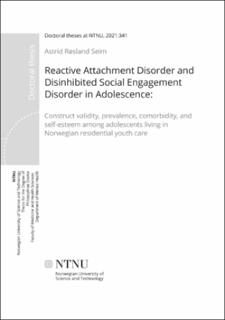| dc.contributor.advisor | Kayed, Nanna Sønnichsen | |
| dc.contributor.advisor | Jozefiak, Thomas | |
| dc.contributor.advisor | Wichstrøm, Lars | |
| dc.contributor.author | Seim, Astrid Røsland | |
| dc.date.accessioned | 2022-02-18T09:54:32Z | |
| dc.date.available | 2022-02-18T09:54:32Z | |
| dc.date.issued | 2021 | |
| dc.identifier.isbn | 978-82-326-5562-5 | |
| dc.identifier.issn | 2703-8084 | |
| dc.identifier.uri | https://hdl.handle.net/11250/2979961 | |
| dc.description.abstract | Reactive Attachment Disorder and Disinhibited Social Engagement Disorder in Adolescence: A study of construct validity, prevalence, comorbidity, and self-esteem among adolescents living in Norwegian residential youth care
Reactive attachment disorder (RAD) and disinhibited social engagement disorder (DSED) are relatively prevalent in children with a history of early inadequate care. However, misdiagnosis of RAD and DSED is common, and there is knowledge scarcity concerning RAD and DSED in adolescence. Controversy persists concerning the construct validity of RAD and DSED in adolescence, and little is known about their prevalence and comorbid psychopathology and psychosocial problems. Furthermore, because self-esteem predicts important life outcomes and mediates the relationship between childhood maltreatment and later psychopathology, knowledge is needed about the previously unstudied global and domain-specific self-esteem in individuals with RAD and DSED.
To promote adequate assessment and interventions for high-risk adolescents, this thesis aimed to investigate RAD and DSED in adolescents living in residential youth care (RYC) with respect to construct validity, prevalence rates, co-occurrence with other psychopathology and psychosocial problems, and global and domain-specific self-esteem. To do so, this study accessed data from the research project Mental Health in Adolescents Living in Residential Youth Care, collected between 2011 and 2014, which included 400 participants aged 12 to 20 years, among whom 381 had information available about RAD and DSED. In-depth semi-structured psychiatric interviews and questionnaires with the adolescents and their primary contacts in the RYCs were conducted to determine mental health problems, psychiatric symptoms and diagnoses, psychosocial problems, and global and domain-specific self-esteem. Access to data from the Young in Norway Study (YiN) of 10,480 adolescents in the general population permitted comparison of self-esteem between adolescents with RAD or DSED and adolescents in the general population.
The results revealed that RAD and DSED symptoms were relatively frequent in adolescents living in RYC, with a prevalence of 9% RAD and 8% DSED diagnosis. Further, RAD and DSED symptom clusters were distinct from each other and from those of other common psychiatric disorders. Nevertheless, adolescents with RAD or DSED symptoms or diagnoses displayed high degrees of co-occurring emotional and behavioural psychopathology and psychosocial problems.
The self-esteem of scholastic competence was low in adolescents living in RYCs regardless of whether they had RAD and DSED. Additionally, having a DSED diagnosis or a high number of RAD symptoms increased the risk of low self-esteem in several domains.
In conclusion, the results support the construct validity of RAD and DSED in adolescence and indicate the importance of providing high-risk adolescents with high quality comprehensive mental health assessment, including RAD, DSED, psychopathology, and psychosocial problems. This assessment should include measures of global and domain-specific self-esteem. Notably, efforts should be made to grasp and acknowledge the complexity and co-occurrence of individual mental health problems in high-risk adolescents, and treatment plans should be adjusted accordingly. | |
| dc.language.iso | eng | en_US |
| dc.publisher | NTNU | en_US |
| dc.relation.ispartofseries | Doctoral theses at NTNU;2021:341 | |
| dc.relation.haspart | Paper 1:
Seim, Astrid Røsland; Jozefiak, Thomas; Wichstrøm, Lars; Kayed, Nanna Sønnichsen.
Validity of reactive attachment disorder and disinhibited social engagement disorder in adolescence. European Child and Adolescent Psychiatry 29, 1465–1476 (2020)
https://doi.org/10.1007/s00787-019-01456-9
This article is licensed under a Creative Commons Attribution 4.0 International License (CC BY 4.0) | |
| dc.relation.haspart | Paper 2:
Seim, Astrid Røsland; Jozefiak, Thomas; Wichstrøm, Lars; Lydersen, Stian; Kayed, Nanna Sønnichsen.
Reactive attachment disorder and disinhibited social engagement disorder in adolescence: co-occurring psychopathology and psychosocial problems. European Child and Adolescent Psychiatry 31, 85–98 (2022)
https://doi.org/10.1007/s00787-020-01673-7
This article is licensed under a Creative Commons Attribution 4.0 International License (CC BY 4.0) | |
| dc.relation.haspart | Paper 3:
Seim, Astrid Røsland; Jozefiak, Thomas; Wichstrøm, Lars; Lydersen, Stian; Kayed, Nanna Sønnichsen.
Self-esteem in adolescents with reactive attachment disorder or disinhibited social engagement disorder. International Journal of Child Abuse & Neglect 2021 ;Volum 118:105141. s. 1-13
https://doi.org/10.1016/j.chiabu.2021.105141
This is an open access article under the CC BY license | |
| dc.title | Reactive Attachment Disorder and Disinhibited Social Engagement Disorder in Adolescence: Construct validity, prevalence, comorbidity, and self-esteem among adolescents living in Norwegian residential youth care | en_US |
| dc.type | Doctoral thesis | en_US |
| dc.subject.nsi | VDP::Medical disciplines: 700::Health sciences: 800 | en_US |
| dc.description.localcode | Fulltext is not available | en_US |
